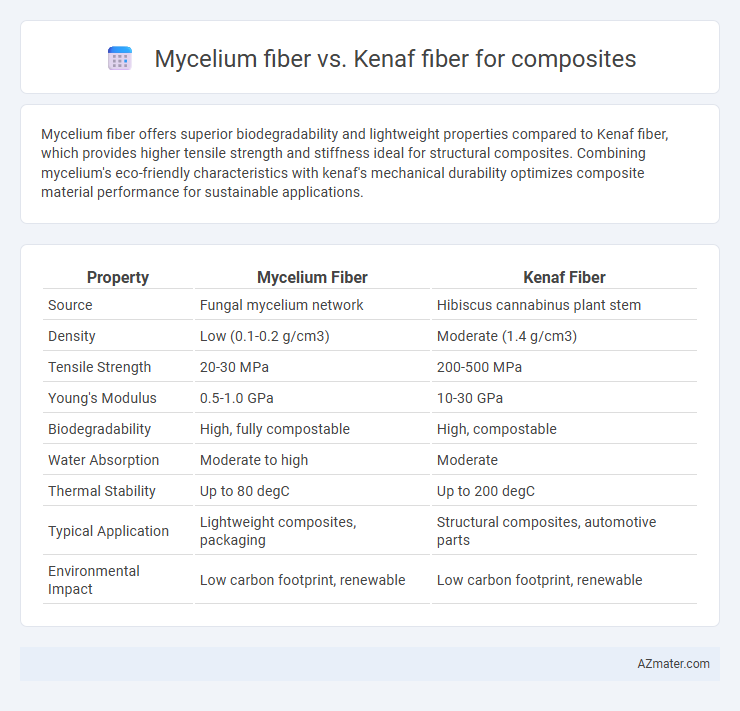Mycelium fiber offers superior biodegradability and lightweight properties compared to Kenaf fiber, which provides higher tensile strength and stiffness ideal for structural composites. Combining mycelium's eco-friendly characteristics with kenaf's mechanical durability optimizes composite material performance for sustainable applications.
Table of Comparison
| Property | Mycelium Fiber | Kenaf Fiber |
|---|---|---|
| Source | Fungal mycelium network | Hibiscus cannabinus plant stem |
| Density | Low (0.1-0.2 g/cm3) | Moderate (1.4 g/cm3) |
| Tensile Strength | 20-30 MPa | 200-500 MPa |
| Young's Modulus | 0.5-1.0 GPa | 10-30 GPa |
| Biodegradability | High, fully compostable | High, compostable |
| Water Absorption | Moderate to high | Moderate |
| Thermal Stability | Up to 80 degC | Up to 200 degC |
| Typical Application | Lightweight composites, packaging | Structural composites, automotive parts |
| Environmental Impact | Low carbon footprint, renewable | Low carbon footprint, renewable |
Introduction to Mycelium and Kenaf Fibers
Mycelium fiber, derived from the root structure of fungi, offers a lightweight, biodegradable alternative for composite materials with excellent thermal insulation and cushioning properties. Kenaf fiber, extracted from the Hibiscus cannabinus plant, is known for its high tensile strength, durability, and eco-friendly characteristics, making it suitable for reinforcing composites in automotive and construction industries. Both fibers exhibit promising potential in sustainable composites, with mycelium emphasizing biodegradability and kenaf highlighting mechanical strength.
Material Origins and Production Processes
Mycelium fiber, derived from fungal mycelium networks, is produced by cultivating fungal spores on organic substrates, enabling sustainable and biodegradable composite materials with low energy input. Kenaf fiber originates from the bast fibers of the Hibiscus cannabinus plant, harvested and processed through retting and decortication to extract long, strong fibers suited for reinforcing composites. The fungal growth of mycelium offers rapid biomass accumulation and self-assembling properties, while kenaf's agricultural cultivation involves mechanical extraction, impacting fiber morphology and composite performance.
Physical Properties Comparison
Mycelium fiber exhibits lower density and higher porosity compared to Kenaf fiber, resulting in improved lightweight composite applications. Kenaf fiber demonstrates superior tensile strength and modulus of elasticity, making it suitable for structural reinforcement in composites. Moisture absorption rates are higher in Mycelium fiber, which can affect dimensional stability, whereas Kenaf offers better water resistance and durability under humid conditions.
Mechanical Strength and Durability
Mycelium fiber exhibits lower tensile strength and stiffness compared to Kenaf fiber, making Kenaf more suitable for high-strength composite applications. Kenaf fiber demonstrates superior mechanical properties, including higher impact resistance and elongation at break, which enhances the durability of composites in structural uses. Durability tests reveal Kenaf composites maintain integrity under prolonged environmental stress better than Mycelium-based composites, which tend to degrade faster due to their organic composition.
Environmental Impact and Sustainability
Mycelium fiber, derived from fungal networks, offers a biodegradable and carbon-negative alternative to Kenaf fiber, which is a fast-growing plant known for its low environmental footprint and high cellulose content. Mycelium production consumes less water and no pesticides compared to Kenaf cultivation, significantly reducing soil degradation and chemical runoff. Both fibers contribute to sustainable composites, but Mycelium's potential for zero-waste manufacturing and compostability highlights a superior environmental advantage in circular economy applications.
Cost and Economic Considerations
Mycelium fiber offers a cost-effective and sustainable alternative to traditional composites, benefiting from low energy requirements and rapid growth cycles that reduce production expenses. Kenaf fiber, while slightly more expensive due to agricultural and processing costs, delivers strong mechanical properties that can justify its higher initial investment in structural applications. Economic considerations favor mycelium for low-cost, eco-friendly composites, whereas kenaf is preferable for higher-performance demands despite increased material costs.
Compatibility with Composite Matrices
Mycelium fiber exhibits excellent compatibility with biopolymer matrices due to its natural cell wall structure, which enhances interfacial bonding and moisture resistance in composite applications. Kenaf fiber offers strong adhesion with thermoset and thermoplastic matrices thanks to its high cellulose content and surface roughness, improving mechanical properties and durability. Both fibers demonstrate promising composite matrix compatibility, with mycelium favoring eco-friendly resins and kenaf excelling in traditional composite formulations.
Applications in Composite Materials
Mycelium fiber exhibits excellent biodegradability and lightweight properties, making it ideal for sustainable packaging and insulation composites in automotive and construction industries. Kenaf fiber offers high tensile strength and durability, suitable for reinforcing polymer matrices in automotive panels, furniture, and building materials. Both fibers enhance composite performance, but Kenaf is preferred for structural applications while Mycelium excels in eco-friendly, lightweight components.
Challenges and Limitations
Mycelium fiber faces challenges in composite applications due to its variability in mechanical properties and susceptibility to moisture absorption, which can compromise durability and strength. Kenaf fiber, while offering better tensile strength and stiffness, encounters limitations related to processing difficulties and compatibility with polymer matrices, often requiring chemical treatments to enhance adhesion. Both fibers demand advancements in processing techniques and treatments to overcome issues of biodegradability, water resistance, and mechanical consistency in composite manufacturing.
Future Prospects and Innovation
Mycelium fiber and Kenaf fiber both present promising future prospects in composite materials due to their sustainable and biodegradable nature. Innovations in mycelium composites focus on enhancing mechanical strength and thermal insulation, while Kenaf fiber advancements target improved fiber treatment techniques to increase durability and compatibility with polymers. Emerging research emphasizes combining mycelium's rapid growth with Kenaf's high tensile strength to develop hybrid composites with superior environmental and functional performance.

Infographic: Mycelium fiber vs Kenaf fiber for Composite
 azmater.com
azmater.com